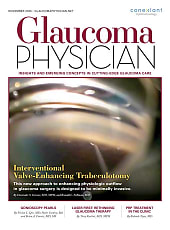New World Medical’s commitment to listening to surgeons has produced an innovation in glaucoma drainage devices: the Ahmed ClearPath ST. According to the company, the nonvalved device builds on the success of the Ahmed ClearPath with new features that increase flexibility to meet patients’ needs.
“When New World Medical launched the original Ahmed Clear Path device, it was based on surgeons’ feedback relative to the limitations of the current nonvalved glaucoma drainage devices on the market,” explains Ray Kong, the company’s chief commercial officer. “Since launch we have continued to gather feedback from surgeons as well as look for trends in the market, with one of those being the surgeons’ desire for a smaller-lumen tube.”
Expanded Options

Figure 1. The Ahmed ClearPath ST has a tube 60% smaller than the original device. Image courtesy: New World Medical.
With a 127-μm inner diameter and a 457-μm outer diameter, the new tube represents a 60% reduction in size compared to the original Ahmed Clear Path, which has an inner diameter of 305 μm and an outer diameter of 635 μm. The ClearPath ST also comes with a prethreaded 6-0 Prolene ripcord and a 25-gauge needle for scleral tunneling.
Mr. Kong notes that the new tube means the Ahmed ClearPath now provides 4 options within one brand to fit every patient’s needs. In addition to the 2 tubes, the brand offers 2 plate sizes—250 mm and 350 mm, enabling surgeons to choose between a single-quadrant implant or a larger implant based on surgeon preference and patient needs.
Other advantages include anterior fixation eyelets designed for easier suture access and a more posterior plate placement, as well as globe- conforming flexible material that allows the globe-shaped implant to provide a more natural fit, while providing a low-lying, diffuse bleb, according to the company.
Benefits of a Smaller-Diameter Tube
A smaller-diameter tube offers multiple advantages, points out Inder Paul Singh, MD, president of the Eye Centers of Racine and Kenosha in Wisconsin. These include potentially fewer issues with corneal endothelial cell loss and the ability to fit into smaller or shallower anterior chambers.
“Because the smaller-diameter tube has a reduced flow, if you ligate it and let it open gradually with a suture, you avoid hypotony, which can cause complications,” explains Dr. Singh, who is an early user of the device. “With a smaller tube, there’s theoretically less chance of that sudden reduction in IOP when it begins functioning.”
Ripcord for Flow Regulation
The ClearPath ST’s prethreaded ripcord, Mr. Kong points out, is key to allowing surgeons options to regulate aqueous flow.
“Historically, [all other GDD’s] do not include a ripcord suture, which means surgeons would have to open a suture and manually thread it into the tube,” he explains. “By including it in the [ClearPath ST’s] packaging already prethreaded in the tube, it provides not only convenience for the surgeon, but also potentially increases the reliability and consistency of the outcome since the tube and suture style, brand, and size is standardized.”
The ClearPath ST’s 6-0 Prolene ripcord, Dr. Singh notes, has enabled him to avoid ligation altogether since he began using the device. He says it is “basically a Prolene suture that stays in the tube and restricts some flow, but then I don’t have to ligate it. So, when I put it in the eye, I don’t secure it with a suture, I just let it stay open, so the patient’s pressures are nice and low right away, postop day one. I don’t have to worry about it opening later. That’s been working really well, giving enough flow, without the risk of hypotony right away.”
The result, he says, is that surgical times are not only shorter, but also less stressful overall.
“I know it sounds simple, but there are a lot of advantages just from a logistics perspective, from flow efficiency, and just overall management postoperatively,” says Dr. Singh. “Having the rip cord can make a big difference.”
A Wider Patient Base
Dr. Singh believes the ClearPath ST does make tube surgery accessible to a wider variety of patients, including those who have significantly high pressures that call for quick action.
“I’m able to utilize this tube in situations that I would not have normally put a nonvalved tube. One of the benefits of a nonvalved tube is that we tend to get less of a hypertensive phase and less fibrosis in the capsule. That’s why I think it does open us up a bit more to a wider variety of patients,” he say. That includes patients whose disease is not as advanced, and so would not yet be candidates for surgery. The Ahmed ClearPath ST “will possibly push tube surgery a little earlier in the disease progression.” GP








